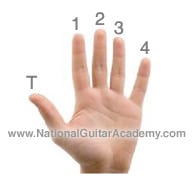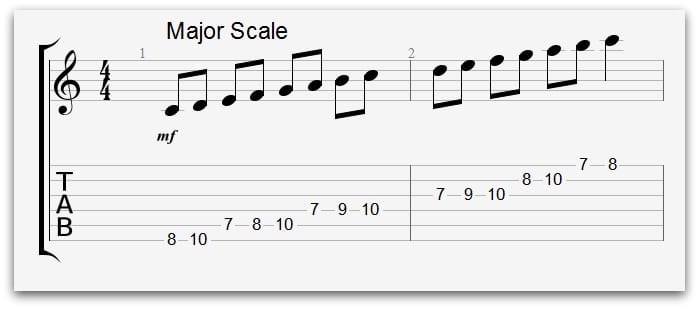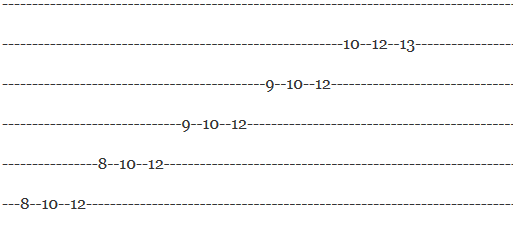Want to learn the C major scale? You’re in the right place!
In this free guitar lesson we’ll show you:
- 3 essential C major scale guitar patterns.
- How to jam with the C major scale and create awesome solos.
- The secrets of the C major scale.
- A bonus scale: the A natural minor scale.
Over 100,000 guitar-learners get our world-class guitar tips & tutorials sent straight to their inbox: Click here to join them
1) What is the C major scale guitar?
The C major scale is an absolute must for guitarists and musicians in general.
Here are two of the most common C major scale patterns.
2) Why should we learn this scale?
Once we know the C major scale, we will understand the key of C. If we know the key of C, we can jam and write music in the key of C.
C major is the easiest key for musicians to think in because it doesn’t contain any confusing sharp or flat notes. It’s an excellent doorway into the world of music theory.
Let’s have a go at playing this essential scale.
Join over 100,000 guitar learners and subscribe to our guitar-tips-by-email service. (It's free.) We'll send you a series of lessons that will move you to the next level of your guitar journey. Learn how everything fits together quickly, easily and effectively. We share ninja tips (for instant fun!) but also timeless fundamentals that will deepen your understanding. To become a better guitarist click here to see our guitar courses Want us to make a guitar-learning plan that is customised to you? Click here for GuitarMetrics™Want free guitar tips and video lessons delivered to your inbox?
Our Guitar Courses
Get your personalised guitar-learning plan 🎸
3) Easy C Major Scale Guitar Patterns
There’s more than one way to play the C major scale on a guitar.
The first C major scale guitar pattern we’re going to look at is ideal for beginners this is the:
- 1 octave open position C major scale.
Here’s the tab:
Not sure how to read tab? Check out this article: How To Read Guitar Tabs
For this pattern, we want to use the:
- 3rd finger (ie. the ring finger) for the 3rd fret.
- The 2nd finger (ie. the middle finger) for the 2nd fret.
- The 1st finger (ie. the index finger) for the 1st fret.
NB: Our thumb doesn’t count as a finger when fretting notes on the guitar. Our fingers are numbered 1-4, index to pinky.
Like this:
Try not to just hop around with one finger or to just use any old fingers. Those are bad habits to form.
We want to get our fingers working and we want them working nice and neatly.
Also, with our picking hand, when we play this (or pretty much any scale) we want to alternate pick.
This means we alternate between down and upstrokes of the pick. Don’t just use downstrokes.
This is time consuming and can sound clunky.
Want to know more about how to alternate pick? Check out this article: Alternate Picking
Here’s a recording of what this scale should sound like:
Try and be patient and play this scale slowly at first. It’s more important to play it correctly than quickly.
Only when we’re completely confident that we can play something slowly should we be thinking about speeding it up.
Once you’re happy you can play this scale, try descending the pattern, ie. playing it in reverse.
Although we’ve called this a beginer’s pattern, it’s one that will serve you well right through your journey as a guitarist. Don’t just discard it and forget it when you move onto more advanced patterns.
4) C Major Scale Guitar – An Intermediate Pattern
Once we’ve gotten to grips with the 1 octave open position version of the C major scale, we can move onto this next closed position C major scale guitar pattern.
This pattern differs from the first in that it doesn’t feature any open strings (hence: ‘closed position’) and covers 2 octaves. (This means we get twice as many notes to play with.)
This pattern is called:
- The 2 0ctave closed position C major scale.
Here’s the tab:
Download our lead guitar cheat-sheet to make things easier
It's hard to understand which scales work with which keys.
So we created a cheat-sheet! A key and scale-finder that you can use again and again.

Get your personalised guitar-learning plan 🎸
Get a custom guitar-learning plan here: Click here for GuitarMetrics™
World-Class Guitar Courses 🌎
Learn from the world's best guitar educators: Click here for our guitar courses
Now, for this pattern, we’re going to use all 4 of our fingers.
As with the previous scale, DON’T just hop about with one finger.
Some of your fingers, especially your 4th finger (ie. the pinky) might feel a bit weak and wobbly compared to the others, but that’s all the more reason to start using it. We need to build up strength in the weaker fingers.
We want to start this scale with our:
- 2nd finger (ie. our middle finger) playing that first note at the 8th fret on the low E string. (6th string.)
Further, we want to use this same finger for every 8th fret note we encounter in this scale pattern.
For the next note:
- Use your 4th finger on the 10th fret of the low E string. (6th string.)
This is the finger we’re going to use for every 10th fret note in this scale.
For the next note:
- Use your first finger on the 7th fret of the A string. (5th string.)
Again, this is the finger we use for every 7th fret note in the scale.
For any notes at the 9th fret, you may have guessed, we use the 3rd finger (ie. the ring finger).
This method of playing is known as: one finger per fret.
When playing a one finger per fret scale we don’t really need to do any moving left to right across the fretboard. Our fingers are already hovering in the frets they need to be in.
Here’s what this scale should sound like:
As with the previous scale, we must be patient and go slowly with this scale at first. Play it correctly, not quickly.
Once you’re happy you know this scale, try descending down the scale.
5) C Major Scale Guitar – Advanced Patterns
If you’ve gotten to grips with the beginner and intermediate C major scale guitar patterns, you might want to try a more advanced pattern.
This pattern is stretchier than our previous two and it requires us to move about more.
It also features three notes on each string, making it ideal for hammer-ons and triplets.
Let’s try it.
The 2 octave, 3 note per string C major scale:
With this pattern we want to start on each string with our 1st finger (the index finger) and finish on each string with the 4th finger (ie. the pinky).
As for the note in between, we can use either the 2nd or 3rd finger, depending on what works best.
If we’ve just played the 8th fret with the 1st finger then it’s less of a stretch if we use the 3rd finger to press the 10th fret.
However, we then have to stretch over to the 12th with our 4th finger, so perhaps our 2nd finger would have been better.
Try both and see which you prefer.
When going from the 9th to the 10th to the 12th, the best fingering is:
- 1st, then 2nd, then 4th.
When going from the 10th to the 12th to the 13th for those final three notes, the best fingering is:
- 1st, then 3rd, then 4th.
Obviously, with this pattern we can’t use the one finger per fret method. We don’t have enough fingers for that, but that doesn’t mean we just start using any old fingers for any old notes.
Our approach to playing the pattern should still be practical and logical.
As with the previous patterns, try descending it once you’re confident you know the pattern.
So why might we learn a pattern like this?
The previous intermediate pattern is a very useful pattern, but it can be a bit limiting when it comes to speed.
Playing fast is by no means the be all and end all of guitar playing, but it is nice to have the option available to us.
NB: as with the previous scales, learn this one SLOWLY before you attempt to do anything fast with it.
Because this scale pattern uses three notes per string, it can allow us that little bit more speed.
Once you’re thoroughly familiar with this more advanced pattern, try playing it as triplet hammer-ons.
This means we only pick the first note of each string and let the other notes sound on their own by simply hammering our fingers onto them.
Not quite sure about hammer-ons? No problem. Check out this video by Jack:
Here’s what this scale should sound like when played as triplet hammer-ons:
Note that the rhythm has a sort of: 123, 123, 123, 123… feel.
That’s why we call these triplets.
Get our best guitar tips & videos
Get our best guitar tips & videos
Where should we send it?











